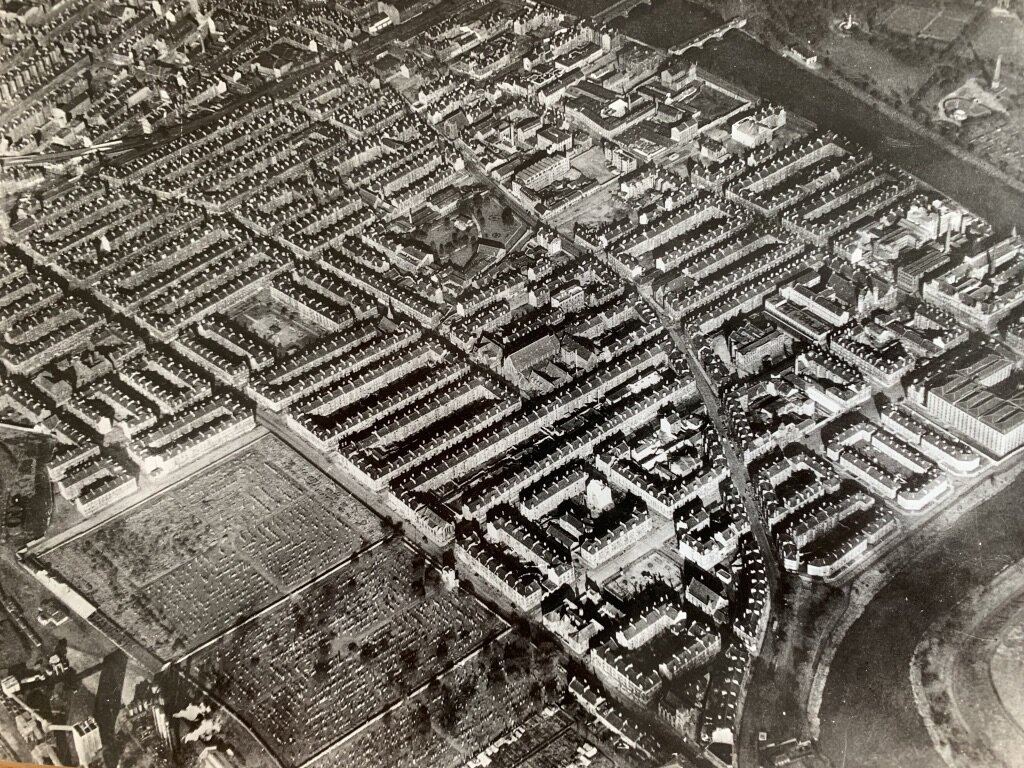Alexander and the Great Glass Tenement
When Alexander “Greek” Thomson set out on his career in the 1850s he lived with his family at 3 South Apsley Place. Long demolished, the tenement once sat amongst what is now the new Laurieston development, south of the River Clyde in Glasgow. The area was primarily residential and home to long blocks of early Victorian tenements which were expanding south and westwards to form the Gorbals. The area would later become synonymous with slum housing conditions, captured in photographs of the tenements from the 1960s that depict the impact of decades of disrepair, but at the time, the Thomson family was surrounded by neighbours that included lawyers, teachers and doctors.
Glasgow’s rapid expansion brought with it major infrastructure challenges that the city could not meet: its water supply largely relied on drawing directly from an increasingly polluted Clyde, whilst the sewage system was unable to deal with the relentless growth of the urban population. Infection and disease raged throughout the city, and Glasgow was not spared from the global cholera pandemic which lasted from the late 1840s through to the early 1860s. Glasgow experienced spikes in 1848-1849 and again in 1853-1854, both of which took the lives of around 1% of the population of the city; the scale of this and the heartbreak it must have brought to Glasgow can be put in perspective by our own experiences of the current pandemic that has taken the lives of around 0.25% of the population and has touched us all in some way.
An aerial photo of the Gorbals post-war, taken to highlight the density of the area prior to its clearance. Authors own.
Thomson and his family were no exception. In the 1850s, they suffered a series of devastating losses at the hands of the ongoing epidemic when in March of 1854 their first child, Agnes Elizabeth, died at age 4. The following year their newly born daughter, Jane Nicholson (named for her mother), was taken from them. In 1856 their new son George was taken from them, and only three days later their 4 year old son, Alexander John, died too.
Following this, and after three years of sustained grief, the Thomson family left their home in the city and relocated to Shawlands - a village at the time - in search of clean drinking water, better sanitation and fresh air. But this wasn’t without its challenges, in particular for Thomson due to the distance he now was from his city centre office and the amount of time he lost to commuting to and from it every day. But despite this, it was at this time that Thomson would embark on what his biographer, Ronald McFadzean, refers to as “The Years of Achievement” where over 15 years he would produce his greatest works, first from Shawlands and then eventually from the home he designed for himself at No. 1 Moray Place.
It’s also during these years that Thomson involves himself in the betterment of the profession, through the Glasgow Architectural Society which would later become the Glasgow Institute of Architects; and the betterment of the city through his engagement with the City Improvement Trust which was brought about through the 1866 Glasgow Improvement Act and aimed to address the slum housing and sanitation issues plaguing Glasgow. The Trust approached the Glasgow Architectural Society for “suggestions on how improvements should proceed”, and a sub-committee was formed of some of the biggest names in Glasgow architecture to consider the matter. Of these, Thomson was one of the most vocal.
Alexander ‘Greek’ Thomson. Supplied to the Alexander Thomson Society by the Thomson Family.
John Carrick, the City Architect, identified a site bounded by Gallowgate, High Street, Trongate and St Andrew’s Square to be the focus of the improvements, and an honorarium of fifty guineas (around £3,000 in today’s money) was paid to six architects for reports and drawings. The architects were Clarke and Bell, John Honeyman, John Burnet, Alexander Thomson, David Thomson and J T Rochead. Carrick also consulted James Salmon (Senior) who served on the Glasgow Architectural Society and was also an Improvement Trustee.
Each approached the issue in different ways, as John McKean describes in a 1994 article:
“Salmon, deploring the tenement, preferred English-style terraced housing; Stevenson favoured conservation of the Old Town; Honeyman favoured conservation and tall, flatted blocks like those being built in England as philanthropic model dwellings.”
Thomson instead opted to pursue a modernisation of the predominant urban form of the city, the tenement. Whilst the others looked to conserve the historic townscape, or tended towards the fashion of the time thinking more about the detail of the block, Thomson took a wider view proposing a contemporary urban block for over 10,000 people. But whilst the scale of this idea was vast, at its core were ideas that Thomson had developed from his own tragic experience of the city’s poor environment. Given what he’d gone through it’s not hard to sympathise with his desire to make big moves that would have an impact on the city rather than tiptoeing around the edge of the problem. Thomson presented his proposals to the Society in 1868 and described them thusly:
“I have made a diagram showing an area of 352,440 square yards, including surrounding streets, upon which may be accommodated very considerably within the requirements of the New Police Act a population of 10,224 . . . There is space in the plan for 112 tenements; those towards the surrounding streets contain 124 shops and 2,272 apartments . . . The main feature of the plan is that the spaces are all open at the ends. There is, instead of a continuous line of building towards the leading street, a series of detached tenements of 48 feet in length with 16 feet spaces between them. These lead alternately into streets covered overhead with glass and lanes providing access to coal and dust carts. Glasgow is notorious for the mortality amongst children. These covered streets are intended chiefly as play-grounds for the young, where they may run about under shelter and out of danger from carts and other vehicles. But the warmth which would result from this method of building would be conducive to the health and comfort of all.”
Sadly, no drawings of the proposals by any of the architects survive, but it is clear from Thomson’s description of his scheme (of which only an abridged version is included above) that when considering the prospect of redesigning the city to better house her citizens on a purely theoretical basis, that Thomson’s ideas focussed on his own experiences during the epidemics his generation faced.
We now challenge you to do the same.
Scott Abercrombie GIA Conservation Committee


